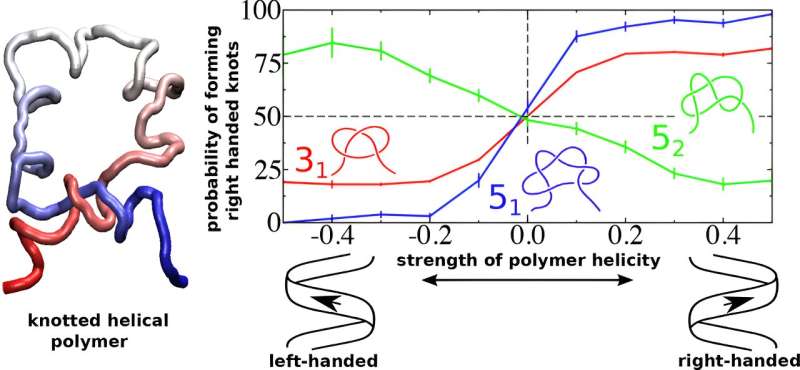This article has been reviewed according to Science X's editorial process and policies. Editors have highlighted the following attributes while ensuring the content's credibility:
fact-checked
peer-reviewed publication
trusted source
proofread
Molecular knots, left and right: How molecules form knots

Helical molecules, similarly to a corkscrew, have a spiral shape that can be either left- or right-turning. Such "chiral molecules" can collectively organize (assemble) into large left- or right-handed twisted structures. These exhibit special optical properties and produce splendid colors, for example, in some insects.
The mechanisms through which the local, corkscrew-like helicity creates handedness of the large supramolecular assemblies are not well understood yet. To explore them, it is useful to start from a simpler problem and investigate how helicity affects the larger structure of single molecules.
Molecular knots are well suited for this purpose: They can exist in a right-handed and a left-handed form, and almost every sufficiently long molecule forms knots like ropes or cables in everyday life do. Additionally, knots involve large parts of the molecule.
One question that was unclear so far is whether the direction of the helical twist on the molecular scale affects the handedness of the larger molecular knots. Say, one has a left-turning helix. Are left- or right-handed knots more probable to form?
A team led by Kostas Daoulas, group leader in the department of Kurt Kremer at the Max Planck Institute for Polymer Research in Mainz, Germany, has now addressed this question, in collaboration with two groups from the University of Mainz led by Peter Virnau (Department of Physics) and Pol Besenius (Department of Chemistry). Their results are published in ACS Macro Letters.
The researchers created a computational model that simulates the knotting of a molecular strand. In their theoretical model, the researchers have introduced forces within the molecular strand that provide for helical twisting. They can increase or decrease this twist by means of a parameter that they set. Furthermore, the sign of this parameter—negative or positive—determines whether the helical twist is left- or right-handed.
The scientists have found that these forces introduced within a molecule have a direct effect on the direction of knot formation of the molecule as a whole. How strongly the molecule is affected depends on the strength of its adjustable parameter.
Their model system shows that the dependence of the handedness of the knots on the direction of the helix stems from special structures spontaneously appearing on the molecule: twisted "braids" formed by two interlaced parts of the helical molecule. Such motifs of molecular packing might play a role also during the assembly of multiple helical molecules into optically active structures.
More information: Yani Zhao et al, Can Polymer Helicity Affect Topological Chirality of Polymer Knots?, ACS Macro Letters (2023). DOI: 10.1021/acsmacrolett.2c00600
Journal information: ACS Macro Letters
Provided by Max Planck Society





















